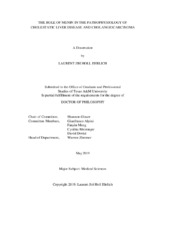| dc.description.abstract | Multiple Endocrine Neoplasia type I (MEN1) is a familial cancer syndrome of the parathyroid glands, pituitary glands, and pancreatic islet cells. Recent evidence has pointed towards a more comprehensive role for menin, the tumor suppressor encoded by the MEN1 gene, in human disease. Cholangiocytes, the epithelial cells lining the bile ducts, become reactive and adopt a neuroendocrine-like phenotype following injury. Since menin has been identified as a tumor suppressor in neuroendocrine-type cancers, we hypothesized that menin may play a role in cholestatic liver disease. Thus, we explored the effects of menin on proliferation, angiogenesis, and fibrosis in several models of cholestatic liver disease as well as cholangiocarcinoma (CCA). Our studies used bile-duct ligation (BDL) and MDR2−/− cholestatic mouse models to study the effects of menin on extrahepatic obstruction and primary sclerosing cholangitis (PSC), respectively. Menin was upregulated using a miR-24 vivo-morpholino, and a meninMLL inhibitor (MI-2-2) was used to block MLL-dependent menin function. Menin was overexpressed in vitro in human CCA cell lines, cells were implanted into nude mice, and animals assessed for tumor burden. Immunohistochemistry (IHC) was performed to measure intrahepatic bile duct mass (IBDM) via CK-19 staining, and Sirius Red staining was performed to measure collagen deposition and fibrosis. Menin expression was measured by real-time PCR and flow cytometry. The fibrotic expression markers fibronectin 1 (FN1), collagen type 1 alpha1 (Col1α1), transforming growth factor-β1 (TGFβ1), and α-smooth muscle actin (α-SMA), as well as proliferative (Ki67) and angiogenic expression markers (VEGFA/C, VEGFR2/3, ANG1/2, TIE1/2) were measured by real-time polymerase chain reaction (PCR). Finally, we assessed alpha7 nicotinic acetylcholine receptor (α7-nAChR) axis activation upstream of menin function using an α7-nAChR−/− BDL mouse model, and an in vitro mechanical stretch system that mimics increased biliary pressure. We found that menin function was positively associated with hepatic fibrosis in cholestatic liver disease and CCA. However, menin overexpression decreased tumor burden in xenograft tumor models. The α7-nAChR expression increases following BDL, and α7-nAChR−/− mice are protected from BDL induced hepatic damage, fibrosis, and biliary proliferation. Mechanical stress increases menin expression, which is abrogated in α7-nAChR−/− cells. We conclude that the role of menin in cholangiocyte disease can be dichotomous. Loss of menin is detrimental in CCA, but potentially ameliorative in fibrotic-type cholestatic disease. The use of smallmolecule inhibitors such as MI-2-2, miR-24 and/or histone deacetylase inhibitors can shed light on menin's mechanism of action and function and could potentially be used as novel targeted therapies. | en |


